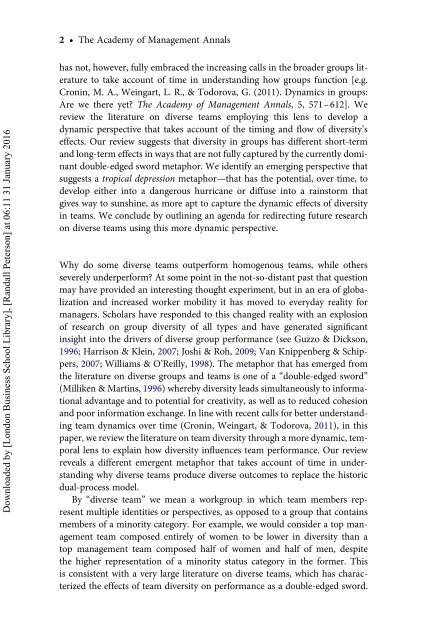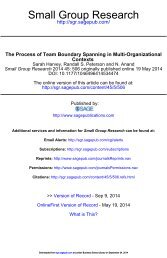A Dynamic Perspective on Diverse Teams: Moving From The Dual Process Model to A Dynamic Coordination-Based Model of Diverse Team Performance - Kannan Srikanth, Sarah Harvey & Randall Peterson
The existing literature on diverse teams suggests that diversity is both helpful to teams in making more information available and encouraging creativity and damaging to teams in reducing cohesion and information sharing. Thus the extant literature suggests that diversity within teams is a double-edged sword that leads to both positive and negative effects simultaneously.
The existing literature on diverse teams suggests that diversity is both helpful to teams in making more information available and encouraging creativity and
damaging to teams in reducing cohesion and information sharing. Thus the
extant literature suggests that diversity within teams is a double-edged sword
that leads to both positive and negative effects simultaneously.
Create successful ePaper yourself
Turn your PDF publications into a flip-book with our unique Google optimized e-Paper software.
2 † <strong>The</strong> Academy <strong>of</strong> Management Annals<br />
Downloaded by [L<strong>on</strong>d<strong>on</strong> Business School Library], [<strong>Randall</strong> Peters<strong>on</strong>] at 06:11 31 January 2016<br />
has not, however, fully embraced the increasing calls in the broader groups literature<br />
<strong>to</strong> take account <strong>of</strong> time in understanding how groups functi<strong>on</strong> [e.g.<br />
Cr<strong>on</strong>in, M. A., Weingart, L. R., & Todorova, G. (2011). <str<strong>on</strong>g>Dynamic</str<strong>on</strong>g>s in groups:<br />
Are we there yet? <strong>The</strong> Academy <strong>of</strong> Management Annals, 5, 571–612]. We<br />
review the literature <strong>on</strong> diverse teams employing this lens <strong>to</strong> develop a<br />
dynamic perspective that takes account <strong>of</strong> the timing and flow <strong>of</strong> diversity’s<br />
effects. Our review suggests that diversity in groups has different short-term<br />
and l<strong>on</strong>g-term effects in ways that are not fully captured by the currently dominant<br />
double-edged sword metaphor. We identify an emerging perspective that<br />
suggests a tropical depressi<strong>on</strong> metaphor—that has the potential, over time, <strong>to</strong><br />
develop either in<strong>to</strong> a dangerous hurricane or diffuse in<strong>to</strong> a rains<strong>to</strong>rm that<br />
gives way <strong>to</strong> sunshine, as more apt <strong>to</strong> capture the dynamic effects <strong>of</strong> diversity<br />
in teams. We c<strong>on</strong>clude by outlining an agenda for redirecting future research<br />
<strong>on</strong> diverse teams using this more dynamic perspective.<br />
Why do some diverse teams outperform homogenous teams, while others<br />
severely underperform? At some point in the not-so-distant past that questi<strong>on</strong><br />
may have provided an interesting thought experiment, but in an era <strong>of</strong> globalizati<strong>on</strong><br />
and increased worker mobility it has moved <strong>to</strong> everyday reality for<br />
managers. Scholars have resp<strong>on</strong>ded <strong>to</strong> this changed reality with an explosi<strong>on</strong><br />
<strong>of</strong> research <strong>on</strong> group diversity <strong>of</strong> all types and have generated significant<br />
insight in<strong>to</strong> the drivers <strong>of</strong> diverse group performance (see Guzzo & Dicks<strong>on</strong>,<br />
1996; Harris<strong>on</strong> & Klein, 2007; Joshi & Roh, 2009; Van Knippenberg & Schippers,<br />
2007; Williams & O’Reilly, 1998). <strong>The</strong> metaphor that has emerged from<br />
the literature <strong>on</strong> diverse groups and teams is <strong>on</strong>e <strong>of</strong> a “double-edged sword”<br />
(Milliken & Martins, 1996) whereby diversity leads simultaneously <strong>to</strong> informati<strong>on</strong>al<br />
advantage and <strong>to</strong> potential for creativity, as well as <strong>to</strong> reduced cohesi<strong>on</strong><br />
and poor informati<strong>on</strong> exchange. In line with recent calls for better understanding<br />
team dynamics over time (Cr<strong>on</strong>in, Weingart, & Todorova, 2011), in this<br />
paper, we review the literature <strong>on</strong> team diversity through a more dynamic, temporal<br />
lens <strong>to</strong> explain how diversity influences team performance. Our review<br />
reveals a different emergent metaphor that takes account <strong>of</strong> time in understanding<br />
why diverse teams produce diverse outcomes <strong>to</strong> replace the his<strong>to</strong>ric<br />
dual-process model.<br />
By “diverse team” we mean a workgroup in which team members represent<br />
multiple identities or perspectives, as opposed <strong>to</strong> a group that c<strong>on</strong>tains<br />
members <strong>of</strong> a minority category. For example, we would c<strong>on</strong>sider a <strong>to</strong>p management<br />
team composed entirely <strong>of</strong> women <strong>to</strong> be lower in diversity than a<br />
<strong>to</strong>p management team composed half <strong>of</strong> women and half <strong>of</strong> men, despite<br />
the higher representati<strong>on</strong> <strong>of</strong> a minority status category in the former. This<br />
is c<strong>on</strong>sistent with a very large literature <strong>on</strong> diverse teams, which has characterized<br />
the effects <strong>of</strong> team diversity <strong>on</strong> performance as a double-edged sword.
















